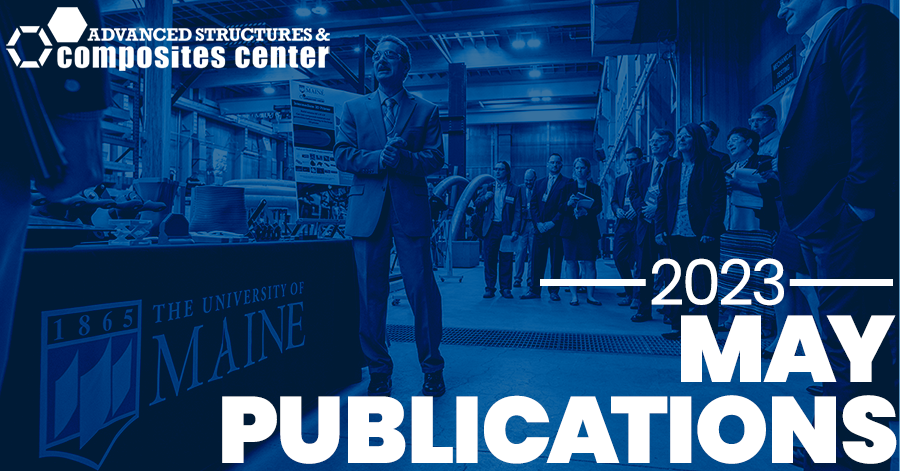
ASCC researchers earn 3 publications in May!
ASCC researchers published in StrUnlocking the Potential of Hydrophobic Cellulose Nanofibrils: Enhancing Composite Reinforcement and Drying Behavioructures
ASCC researchers Megan Driscoll, Peter Kelly, and William Gramlichdrew Schanck were published in Langmuir.
An article by ASCC researchers Megan Driscoll, Peter Kelly, and William Gramlich was published in Langmuir. Titled “Impact of Aqueous Grafting of Polystyrene through Methacrylate-Modified Cellulose Nanofibrils on Emulsion Stabilization and Drying Behavior”, this research explores how the hydrophobic modification of cellulose nanofibrils (CNFs) releases the capability for composite reinforcement including CNFs without energy-demanding spray drying.
The hydrophobic modifications of CNFs presented by Driscoll, Kelly, and Gramlich represent a significant milestone in CNF technology; by addressing hydrophobic limitations and overcoming fibrillar collapse, these breakthroughs unlock the potential applications of CNFs in a variety of industries. The improvement of composite properties through stable drying offers opportunities for more energy-efficient processes and allows for material development that is more viable and sustainable. The increased stability of hydrophobic CNFs (PS-MetCNFs) during the drying process makes them more accessible for projects that require hydrophobic materials and allows for the creation of composites that are both lightweight and high-strength.
Researchers find nearly 500% increase in surface area compared to unmodified CNF
Researchers from the University of Maine, in collaboration with Oak Ridge National Laboratory (ORNL) have published a journal article titled, “Polymer-Grafted Cellulose Nanofibrils with Enhanced Interfacial Compatibility for Stronger Poly(lactic acid) Composites” in Applied Polymer Materials on their work developing polymer-grafted cellulose nanofibrils (CNFs) for stronger poly(lactic acid) (PLA) composites. This research, which is a part of the Hub & Spoke program, is significant as it could pave the way for the large-scale manufacturing of CNF/PLA composites, which could have numerous applications across various industries.
CNF, a type of nanocellulose and the most abundant biopolymer on earth have shown potential as a reinforcement for biodegradable composite matrices such as PLA, but they require commercially scalable drying methods that preserve their fibrillar morphology along with improved interfacial interactions with polymer matrices. In this study, researchers used a water-based grafting-through polymerization scheme to modify CNFs, which improved spray drying behavior and reinforcement capacity in PLA composites.
The researchers, Peter Kelly, Siamak Shams Es-haghi, Meghan Lamm, Katie Copenhaver, Soydan Ozcan, Douglas Gardner, and William Gramlich found that all polymer modifications yielded CNFs with a more fibrillar morphology, or the physical structure or shape of a material or substance that consists of long, thin fibers or fibrils after spray drying, increasing specific surface area by up to 490% compared to unmodified CNFs, values similar to conventional freeze drying. Moreover, polymer-grafted CNFs in PLA composites improved the tensile strength by 16% at 20 wt % loading and stiffness by 22% at a 10 wt % loading with two different graft-polymer chemistries compared to unmodified CNF composites.
To understand the improvements in composite properties, the researchers employed surface energy heterogeneity measurements of the reinforcements and PLA matrix. They found that polymer modifications lowered the total surface energy of the CNFs, and calculated ratios of work of adhesion to work of cohesion suggested improved interfacial compatibility for four of the modified CNFs with PLA.
The researchers also conducted rheological oscillatory shear studies of the composites, which correlated solid-like melt behavior, as demonstrated by storage moduli dominance, with higher tensile strength. Thermal analysis of the composites revealed that excessive plasticization by the poly(oligoethylene glycol methyl ether methacrylate)-grafted sample potentially offset mechanical property improvements imparted by the more fibrillar morphology.
The researchers’ work provides an opportunity for large-scale manufacturing of CNF/PLA composites via an entirely aqueous modification scheme and industrially relevant spray drying process. This study’s findings could have significant implications for the development of sustainable and biodegradable materials for various industries.
The Breakthrough Offshore Wind Project that Puts ASCC Technology at the Forefront of Climate Solutions
The groundbreaking New England Aqua Ventus I (NEAV) Offshore Wind project, funded by the US Department of Energy (DOE), is set to revolutionize the offshore wind industry and establish America as a leader in renewable energy. The project utilizes the innovative VolturnUS technology, a prestressed concrete semi-submersible floating hull, capable of harnessing 60% of the US offshore wind resources near the coast. Over 20 years, a full-scale commercial wind turbine will be deployed off Monhegan Island, Maine, showcasing America’s commitment to clean energy and sustainability.
The NEAV project has achieved significant milestones, including the completion of the design for a 6MW floating offshore wind turbine hull, which passed a thorough review by the American Bureau of Shipping. The project also secured substantial investments, amounting to $100 million, through rigorous technical due diligence reviews. Furthermore, a Power Purchase Agreement with the State of Maine reinforces the commitment to clean energy accessibility and affordability.
Environmental stewardship is a key focus of the NEAV project, with ongoing efforts to secure permits, engage with communities, and collect vital environmental data. Additionally, comprehensive plans for construction, operations, and financing have been developed, ensuring the project’s viability.
The NEAV project represents a monumental step towards a sustainable future, showcasing America’s determination to lead the world in renewable energy transition. With projects like NEAV, the nation can generate clean power, stimulate economic growth, and reduce greenhouse gas emissions, inspiring global commitment to a greener tomorrow.
